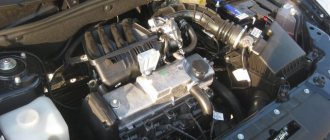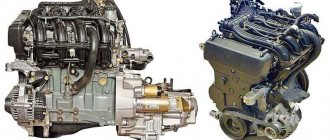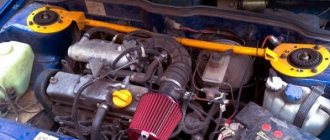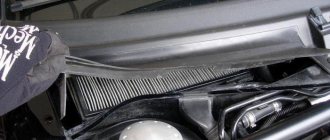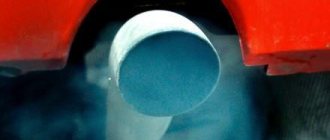Despite the huge amount of criticism against the Lada Priora, this is one of the most popular cars that have come out of the AvtoVAZ assembly line in recent years. The Priora is equipped with a fairly successful engine with good dynamics, and the interior is very comfortable. And the maximum trim levels offer useful options. But at the same time, from time to time the car brings minor problems to its owners. One of the most popular malfunctions is that the Priora engine (16 valves) is tripping.
How can you tell if the engine is actually stalling?
The very first and main task of the driver when such a problem is detected is to accurately determine that one of the cylinders is not working. To do this, you can use the diagnostic tools built into the car. If the engine is old, then the search for a non-functioning cylinder will be discussed below.
In general, the indicators of engine “triple” are as follows. You will feel rattling and vibration in the cabin, which disappear when you press the gas. Also one of the symptoms is the car taking a long time to warm up at low temperatures. You can hear this problem - the operation of the motor will be irregular, and one beat can be heard missing.
If the Priora engine adjusts 16 valves at idle, this will be accompanied by loss of power and increased fuel consumption. If the “Check Engine” light comes on on the instrument panel, and there are also other symptoms from the list above, then the engine is definitely faulty.
Why is this defect dangerous?
If the power plant stalls during acceleration, it can be very dangerous, especially when the driver is overtaking and there is oncoming traffic ahead. The power decreases, the overall compression ratio decreases, and the dynamics of the car may simply not be enough to complete the maneuver. Therefore, the car needs urgent repairs.
In addition to a drop in power, twitching, lack of dynamics and other unpleasant sensations, an engine running without one cylinder can very quickly become completely unusable. The reason here is quite banal: fuel continues to flow into the idle cylinder, but it does not burn. The fuel, of course, is thrown back through the valve, but some of it inevitably remains on the cylinder walls. Since the rings cannot perfectly clean the cylinder walls, some of the gasoline mixes with the oil and enters the crankcase. The mixture of oil and gasoline is not sufficient for good lubrication, so the engine overheats.
The piston burned out due to overload
In addition, scoring occurs on the cylinders and the piston group deteriorates. Due to colossal wear, the compression ratio is reduced, so the owner is forced to overhaul the engine. Considering that the Priora has been produced since 2007, you can often find cars that have a knocking sound in the engine, like a very old 20-year-old car. The reasons are the same - driving a motor that revs when accelerating. The car may have new firmware, but if one of its cylinders regularly starts to switch off, it will not drive for long.
It should be noted that there can be many reasons for such a problem. These reasons can be easily eliminated even without any material costs, or you may even need to replace the Priora engine or completely repair it. But what you absolutely cannot do is drive for a long time when the engine is running rough. If a breakdown occurs far from home, you need to at least drive very slowly, monitor the temperature gauge so that the engine temperature does not exceed the norm, and be sure to check the oil level before driving. The engine speed should be kept in the lower or middle zone of the tachometer.
Poor quality gasoline
Troubleshooting on all VAZs can primarily occur if low-quality fuel gets into the air-fuel mixture formation system. Thus, most domestic gas stations do not have a very good reputation due to the fact that they sell fuel that does not meet the standards.
Problems with car tripping are often hidden in low-quality fuel.
So, if gasoline has already entered the system, it most likely clogged the gasoline supply system, and possibly left its mark on the spark plugs. In the worst case, what all car enthusiasts fear is burnout of the valves or piston mechanism.
Therefore, it is better to take the choice of a gas station seriously, since major engine repairs will cost more than saving on good gasoline. It is recommended to overpay a little for fuel, to regularly change fuel cells and carry out constant repairs.
Air supply
Normal air supply is the key to the formation of an air-fuel mixture and a normal combustion process. Thus, a malfunction of one or more air supply elements can lead to the engine starting to choke. These include the air filter and throttle valve.
Contamination of air elements is the reason why a car stalls..
The air filter element must be changed every 20,000 km, since after this it becomes clogged and becomes unusable.
But it is necessary to monitor the condition of the throttle valve, since it is unknown when it will become clogged and begin to cause problems. Typically, motorists clean this unit themselves, using special products or a carburetor cleaner.
Car spark plugs
The main source of the engine trimming at idle speed is the spark plugs. If one of them does not work correctly, the engine will shake - one of the cylinders does not work.
To find out which candle is not working, you can use the old method. Despite the fact that this diagnostic method is ancient, it can be used to very quickly and effectively find a broken spark plug.
You need to start the engine and then remove the spark plug cap from each cylinder in turn. If, when you pull the wire from the spark plug, the engine tries to stall, then the spark plug is in full working order. If the motor does not react in any way to pulling off the cap, then the spark plug in this cylinder is not working.
There is another method. After the engine is running at idle, you can unscrew the spark plugs and inspect them visually. Usually you can identify a non-working spark plug even with the naked eye. It will be filled with fuel. There will also be no characteristic soot on it. The faulty spark plug needs to be replaced and then engine operation will return to normal.
see also
Comments 12
it was about the same thing, the oxygen sensor died! just unplug the plug and check if it works or not. but the check engine light comes on!
This happened to me: the coil died, the next day I replaced it with a new one, but the black smoke due to overflow never stopped coming out of the exhaust pipe. I unscrewed the spark plugs, they were covered in black soot, replaced them with new ones, it didn’t help. Then I unscrewed the oxygen sensor, and it was also very heavily carbonated. After replacing the DC everything became normal.
Checking the ignition coil - Disconnect the ground wire from the battery. — Remove the cover from the ignition coil and disconnect the wire from it. — If the plug comes out of the coil, replace the coil. — Check the coil for cracks, replace if necessary. — Measure the resistance of the primary winding of the coil by connecting an ohmmeter to the contacts. — Measure the resistance of the secondary winding of the coil by connecting an ohmmeter to the contacts. — Connect the wires to the ignition coil. — Install the coil cover. — Connect the ground wire to the battery. If you are going to replace the ignition coil, do not install a regular coil controlled by the ignition chopper under any circumstances, otherwise the control computer will be damaged.
Many Lada Priora engine owners have experienced the engine starting to misfire. What are the reasons for this effect? Let's consider the main ones, as well as methods for troubleshooting.
Fuel system
Continuing the topic of modern injection engines, it should be noted the problems associated with clogged injectors.
In this case, the injection of the fuel mixture is uneven, and as a result the engine trims at idle. Experts recommend cleaning the fuel system more often, cleaning injectors, and refueling with high-quality fuel. Sometimes it happens that the problem appears after refueling with unknown gasoline at unfamiliar gas stations.
Another reason is fuel pressure. It can be either insufficient or too much. If a pressure regulator is installed in the fuel rail, then the ideal indicators are approximately 2.5 bar at idle. If the regulator is in the tank, then the pressure should be maintained at 3.8-4.0 bar. If the pressure does not match, then it adjusts the Kalina engine at idle. This phenomenon is typical not only for Kalina, but also for Priora.
When warming up, the Priora's engine starts to sputter
yeah, try without a connector, but in general, of course, you need a computer in the car. I read it quickly and am convinced.
Wrong! He writes about misfire, and this can cause the injector to malfunction, just like the coil and spark plug
yeah, try without a connector, but in general, of course, you need a computer in the car. I read it quickly and am convinced.
Wrong! He writes about misfire, and this can cause the injector to malfunction, just like the coil and spark plug
yeah, try without a connector, but in general, of course, you need a computer in the car. I read it quickly and am convinced.
Wrong! He writes about misfire, and this can cause the injector to malfunction, just like the coil and spark plug
On the issue of the difference between “IGNITION” and “ignition” misfires
I'd start with the temperature sensor.
Because I’m not sure that your 36 degrees actually = 36 degrees.
But the strange thing is that when starting the engine everything is ok, but when heated to 36 degrees. tripling begins
Same crap on cylinder 4. on the 8th valve is the valve adjustment. tested more than once. I’ve been trying to find time to go to this procedure for the second week now.
I can’t even imagine what to do with 16 valves. Maybe the hydraulic compensators are not working as they should?
Why is the check engine blinking and the engine shaking? The car began to slow down.
, the engine does not pull, it jerks. I turn off the ignition. , I start it again and it’s fine.
- There is no flash in the cylinder - check if there is fuel. At a normal compression level, you need to test the operation of the accounting power system. Focus on the air filter and pipe: are the clamps tightened tightly, what is the condition of the purifier box, is the air intake from outside adjusted. The tubes located on the throttle assembly are made to be firmly fixed to it. Traces of fuel leaks, visible cracks and chipped plastic are unacceptable.
- The engine may stall
due to a clogged injector. For this reason, specialists categorically do not accept filling the tank with cleaners sold for injectors. In fact, no cleaning occurs - the contaminants peel off in the tank, and then the fuel line becomes clogged. There is a build-up in the small nozzle and it will get stuck. - The winding of the injector parts burned out.
- Low quality fuel.
- Test the spark plugs.
Ignition
But it may turn out that when you unscrew the spark plug, you will see that it is wet. This indicates there is no spark. As a result, fuel combustion does not occur. The ignition is checked in the following order:
- First, let's visually evaluate the candle. It should be brown-sand color. If it is darker, then it may be faulty. It is advisable to check it on a special stand. The spark should be blue and white. If it is yellow or red, then this is a bad sign. You can, of course, try to clean it with sandpaper, but this may not bring the desired effect;
- Try using another spark plug and check how the engine runs. If everything returns to normal, then the cause has been found. Also check the high voltage wire;
- After this, check the ignition coil. It is the weakest ignition part in the Priora. To check, we reset errors from the ECU. And with the ignition off, they swap the supposedly non-working ignition coil with the obviously working one. The engine starts for a couple of minutes. The diagnosis is repeated. If the flash miss “migrated” along with the coil, the problem is in it. Replace it with a new one.
Source
Wire diagnostics
If the engine is adjusting on the canvas, then experts recommend making sure that the wires are in good condition.
One of the easiest diagnostic methods is to use a working wire. It is installed on each of the cylinders. If after these steps the engine begins to operate stably, then it is worth replacing the entire kit.
To find the breakdown, you need to wait until it gets dark outside. In the dark, open the hood and start the engine. The breakdown, if there is one, will be clearly visible - a spark will strike at the place of the breakdown.
If you have an additional insulated cord, you can also check the serviceability of the high-voltage wires. It is necessary to strip the ends, and then one end of the wire is shorted to ground. The other end is driven along the surface of the cord - special attention should be paid to bends, caps, and joints. If there is a breakdown, then a spark forms between it and the wire.
Finally, you can check the resistance using a multimeter. The device is switched to resistance testing mode. Then the multimeter contacts are connected to the two ends of the wire. If the cord is working properly, then its resistance will be in the range of 3.5 kOhm to 10 kOhm. If the resistance threshold is higher, then it is better to replace the wires.
FakeHeader
Comments 33
I updated the entry due to a change in the state of the problems, it may be useful to someone)
look in my blog. A good help for these symptoms is flashing the ECU and cleaning the throttle. If the pedal is not electronic (e-gas), then you can install imported IAC and TPS sensors made by GM, but they are not cheap.
Unstable operation of the engine and failures in its operation, exhaust popping, exactly such symptoms were and did not always appear, the fault was the ignition coil, it was breaking somewhere
just one, because they had already gone through everything new, including all the sensors, spark plugs, plus the engine had been repaired, so one suspicion remained, these coils sometimes break through, as in my case, as most likely in yours, but sometimes they simply fail, then you can feel it)
By the way, I have this problem, everything is fine, XX is at 800-850, but sometimes in a traffic jam it just drops to 300-400 and the car stalls, it happened 3 times and all in one day, it doesn’t seem like this happened again, but still sometimes I bet that where is the thread in the MSK in lane 3 I’ll stall and won’t start.)
You need to buy a spare)
buy a new one and wash this one, blow it out and leave it in a bag as a reserve. If this occurs, simply change it and the problem will disappear at the time of purchase.
put all the factory sensors in place, I had such crap when accelerating in fifth gear it still jerked, the car was 7 years old, I had to change all the ignition coils and the Priorik drove almost 200
Unfortunately, there are no factory sensors, as I am far from the first owner of the car)
Most likely air is leaking into the throttle body. For example, from under the rubber seals on the injectors. About once every 30 seconds at idle, the adsorber can be purged, and the mixture (already lean) becomes even leaner - hence the drop in speed. And one more thing: People, when will you stop doing nonsense?! Why do you think DIAGNOSTICS is needed? Just to count and reset errors? - This is a deep misconception! Diagnostics is a method of finding an engine malfunction through various kinds of measurements and LOGICAL INFERENCES, which allow us to identify EVEN MECHANICAL MALFUNCTIONS, even when no check light is yet on and the driver himself has not even had time to feel that this malfunction already exists! Why is everyone smart enough to connect a laptop, but when asking questions here on the forum, only a few provide any significant information?! I mean the readings of the same diagnostics (sensor readings), or engine operation logs in general. Having all this data, in 99% of cases, specialists can either determine the cause, or significantly narrow the range of malfunctions and prescribe certain other inspection/test procedures to finally confirm the cause, if after the first stage there are still options/doubts.
By asking for advice on forums, you waste more time, nerves and money, and in most cases the problem still remains! Hundreds of different malfunctions can have the SAME SYMPTOMS, and hundreds of people will foam at the mouth (from their own experience) to prove that they are right, but in the end the cause will be completely different.
When something hurts, do you also ask on the advice forum how to treat it? Or do you still go to the doctor and get tested?
I don’t tell everyone to go for diagnostics - the vast majority of services there are also amateur charlatans! Just when asking for advice here, try to provide at least a little data useful for diagnostics, and then you will be given the correct answer to your question much faster.
I was at the service and they threw up their hands. Well, I just don’t know proven and good specialists. Regarding the data - I wrote below about the recreation center, I can also provide IAC steps, air flow. Well, actually, everything may be required (since I don’t have much experience, I don’t know exactly what is needed). And if someone tells me what evidence is needed, I’ll look and sign off.
Read more: What to do to avoid fogging
Set the display: XX sign, air flow, throttle position, DK1 state, air and coolant temperature, OZ, IAC, injection time, and sign of adsorber purge. Record a video when the car is not working well so that all these readings are visible, and post the link here - we’ll see...
On the previous Priora I suffered a little and ate money, the car struggled when cold and sometimes when accelerating there was a sharp throttle and the check engine started blinking, the engine and everyone listened, it works like clockwork and the compression was measured twice everywhere like new, and I changed the coils and injectors I cleaned it, but I always sinned on the injectors and valves, so I sold it the next day, I told the owner so, and the nostalgia for this particular car is still not comparable to any Priors that I had, it drove differently and that’s all ).
The problem is the same as yours #2. I don’t even know what to blame, but I think I’ll start with pxx, because after turning it off, no changes occur.
My car stalled when I turned off the rcx. Check the TPS, they often recommend looking at it. Although I changed 2 - it didn’t help)
Our engines are the same, only I have E-gas, in general, I had something similar when the oxygen sensor died, it didn’t throw an error, but it was impossible to drive when it was cold, the exhaust was not smooth, it stuttered when you picked up speed, in short, you drove like crazy. Once I replaced it, everything fell into place. I also tormented the ignition modules later, even when I replaced all the factory ones with Bosch ones, they continued to torment me, also without errors, it turned out that one new Bosch module began to die after a month
Advice and recommendations from experts
As you can see, if the VAZ-2110 engine trims at idle, then the reasons for this operation can be very different. It should be understood that various malfunctions in the operation of the ignition distributor or fuel pump can also provoke tripping. But in this case, the engine will fire three times in each cylinder.
In some cases, to solve the problem you need to fill in high-quality fuel and warm up the engine well. In other cases, cleaning the spark plugs and replacing the wires will help. And although in most situations these simple actions save the situation, sometimes they may not work.
If there are deviations in the engine's operation, then this is already a reason to replace the spark plugs along with the filters. You also need to clean the power system, check the fuel pump and fuel pressure. Computer diagnostics can also be performed. But the problem needs to be dealt with immediately - if ignored, it can lead to expensive repairs in the future. You should not ignore this symptom - it is better to look for problems in time.
So, we looked at the reasons for unstable engine operation at idle, and also found out how this problem can be eliminated.
Knocking after replacement
Usually new parts don't knock.
If you still hear sounds, then this is a manufacturing defect or a problem with the valves. In order to perform an accurate diagnosis and make sure that there is nothing wrong with the valves, it is necessary to check their fastenings. There is a possibility that the parts did not shrink as required. We simply tighten them and thereby remove the knock of the hydraulic compensator.
Sources
- https://maslo-5w30.ru/avto/stuchat-gidrokompensatory-priora-16-klapanov-prichiny
- https://medwegonok.ru/dvigatel-lada-priora-16-klapanov-stuchit-gidrokompensator/
- https://avtonomnaya-gazifikaciya.ru/dvigatel/pochemu-stuchat-gidrokompensatory-na-priore.html
- https://zsm-miass.ru/polomki-i-remont/gidriki-na-prioru.html
- https://avtonomnaya-gazifikaciya.ru/dvigatel/kompensatory-priora.html
- https://medwegonok.ru/stuk-gidrokompensatorov-priora-16-klapanov-kak-ustranit/
- https://AvtoSotka.ru/motor/stuk-gidrokompensatorov-na-holodnuyu-priora.html
Sensors
One of the common reasons why the VAZ-2115 engine adjusts at idle is sensors. The main culprit for unstable operation is the mass air flow sensor or mass air flow sensor. In addition, you should definitely check the throttle position control element or TPS and the idle speed control. DPKV can also create problems (affects the operation of the crankshaft).
Along with problems associated with sensors, various malfunctions can also be identified that are directly related to the ECU itself. There are cases when the Priora engine simply slightly adjusts at idle, and diagnostics using electronic priors reveals errors that cannot be eliminated.
Sometimes the engine misfires due to ECU tuning that is popular today. After flashing, which is not recommended by the manufacturer, characteristic symptoms of tripling may appear.
Valves and problems with them
On most domestic cars, as well as on some old foreign cars, it is necessary to adjust the thermal valve clearances at intervals of 10-20 thousand kilometers. If you do not make adjustments, then the valves may not close tightly or not open completely. For this reason, the engine may also stall at idle and even stall. The reason is simple and banal - the valve timing is disrupted.
It happens that during operation of the engine the valve burns out - this will definitely affect the operation of the engine. Such a malfunction can be detected by low compression in the cylinder. If the problem is associated with ordinary wear or partial destruction of the rings, then experts recommend pouring a little oil into the cylinder and measuring the compression with it. If, as a result of the measurements, the compression has increased, then the damaged valve must be replaced.
Replacing hydraulic compensators on a Priora (16 valves)
For work, prepare the following tools:
- flat-head, Phillips-head screwdriver;
- socket wrenches;
- You may need a cylinder head gasket; replacing it will allow you to be safe from the fact that the spark plugs may flood the spark plugs with oil;
- sealant;
- magnet - for convenience.
- Stop the car with the handbrake. Lift the hood.
- Loosen the clamp securing the crankcase ventilation hose (main circuit).
- Disconnect the hose from the cylinder head fitting. Cover the fitting with rags to prevent any objects from getting inside.
- Remove the bracket for the wires of the injectors and ignition coils, having first unscrewed the bolts with the “10” head.
- Disconnect the throttle assembly wiring harness from the cylinder head, having first removed the fastenings with the same head.
- Let's move on to the cylinder block cover. All fifteen screws will have to be unscrewed. To do this, use the E-8 head. Please note that it is additionally secured with sealant.
- Therefore, use a plastic screwdriver to carefully pry the cover in places where there are visible gaps, and then lift it. At this point, evaluate the camshaft lobe wear. It should not be covered with chips or other signs of mechanical damage.
- Now you can check the faulty hydraulic compensators. Avoid damaging the valves of the gas distribution mechanism; handle them carefully.
- Remove the faulty hydraulics with a magnet and put new ones in their place, securing them in a level position.
- Along the way, you should inspect all parts, assessing the degree of wear. This will help to find the reasons for the wear of the hydraulics or the consequence - something that has worn out faster due to their improper operation.
- Replace sequentially. Do not forget to coat the cylinder head cover with sealant to ensure maximum adherence to the body.
- Reassemble the components in reverse order, check the operation of the new hydraulic tappets by starting the engine.
Particular attention should be paid to oil seals, as they are most susceptible to wear. The seals of the Russian manufacturer of wear-resistant auto components CS20, which specializes in the production of silicone, polyurethane and rubber spare parts, have proven themselves to be good. Detailed review follow the link.
How hydraulic compensators knock: video
Why the engine won't start
In order for the power unit to start successfully, the following conditions must be met:
- normal crankshaft rotation speed has been achieved;
- proper compression;
- good battery charging;
- quality fuel.
Thus, if the Priora’s engine does not start, you should suspect a problem based on one of the above points.
First of all, knowledgeable car owners check:
- battery;
- wiring;
- starter.




